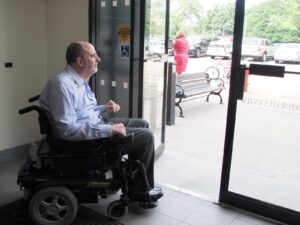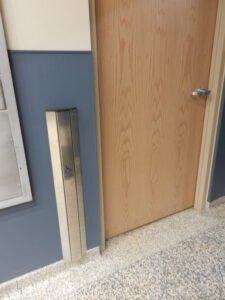
New automatic door requirements for accessibility
Automatic doors offer convenience, improve building access for people, help reduce energy usage in a building, and can also improve hygiene control
Automatic doors offer convenience, but also have additional benefits. Automatic doors improve building access for persons using wheelchairs, scooters or walking aids, as well as parents pushing strollers, customers pushing shopping carts or people carrying items in their hands.  Automatic doors can help reduce energy usage in a building by opening and closing in a timely manner, thus helping to maintain the heating and cooling of the building. Automatic doors can also be a benefit in areas where there is a concern about hygiene control. Options that are hands-free have been used for many years in areas where sanitation is important — such as hospitals, food processing plants and laboratories. In addition, many businesses have added automatic doors as part of their response to help lessen the spread of COVID.
Automatic doors can help reduce energy usage in a building by opening and closing in a timely manner, thus helping to maintain the heating and cooling of the building. Automatic doors can also be a benefit in areas where there is a concern about hygiene control. Options that are hands-free have been used for many years in areas where sanitation is important — such as hospitals, food processing plants and laboratories. In addition, many businesses have added automatic doors as part of their response to help lessen the spread of COVID.
There are three types of automatic door operators used for pedestrian doors that are addressed by the automatic safety standards referenced in the building codes and developed by the Builders Hardware Manufacturers’ Association (BMHA A156 standards). The three main types are:
- Power-operated doors — Doors that open for pedestrians with door opening initiated by a motion sensor or pressure pad.
- Low-energy, power-operated doors – Doors that open for pedestrians by operation of a button or panel control near the door.
- Power-assist doors — A door with a mechanism that reduces the opening force to operate a door. If the opening force on the door is released, the door will close. Power assist doors are not very common, but are typically used on very large doors.
The three types of automatic door operators can be used on side swinging, sliding, or revolving pedestrian doors. Revolving doors cannot serve as part of an accessible route.
The primary focus of this discussion are the revisions to the automatic door opener requirements in the 2021 and 2024 International Building Codes (IBC), and the referenced accessibility standard, 2017 ICC A117.1 Standard for Accessible and Usable Buildings and Facilities (ICC A117.1).
Exterior doors do not have an opening force in the IBC, ICC A117.1 or 2010 ADA standard. Due to pressure differences between the inside and outside of buildings, the direction and force of the wind outside, and the need of exterior doors to stay closed to keep heated or cooled air inside the building, exterior doors would not have a consistent opening force that could be uniformly met. Regulations must have requirements that can be consistently met. However, in consideration of their customers and staff, many building owners voluntarily provide an automatic door at a primary entrance.
Where an exterior door providing a power-operated or low energy power operated door, the door maneuvering clearance at the doors is not required for entry in the building (2017 ICC A117.1 Section 404.3.4). A maneuvering clearance is required at a power assist door. Vestibules with a power operated or a low-energy power-operated door on the exterior and interior side of the vestibule do not have to have a turning spaces within the vestibule since the automatic doors minimizes the chance of entrapment in the vestibule by opening the doors for you (2017 ICC A117.1 Section 404.3.6). However, if an automatic doors is used as part of an accessible means of egress route, maneuvering clearance is required on the in the direction of egress travel in case the doors loose power. The exceptions allow for alternatives for loss of power to the door would be addressed by 1) battery backup; 2) the door would unlock/unlatch or 3) the door has a break-away feature. These three options would allow for free egress without additional maneuvering clearance at the doors on the egress side.
For low-energy power-operated doors, where a person sits in their wheelchair to manually operate the door opener, must be clear of the door swing so the door would not open and hit them (2017 ICC A117.1 404.3.7). Best practice would also locate the operator so someone could roll straight in from that location and not have to back up or move around the door. While a button or control within reach range is acceptable, there are new styles where you wave your hand in front of a sensor to open the door, or the control is a tall bar that can be pushed with a hand or a foot plate.
 The 2021 IBC has incorporated a requirement for automatic doors in some occupancies (2021 IBC Section 1105.1.1). Groups A-1 through A-4 include basically all assembly occupancies other than outdoor assembly (Group A-5). Examples are theaters, restaurants, museums, places of religious worship, and indoor sporting activities. Group B, M and R-1 are business, mercantile and hotel occupancies respectively. Where the occupant load in the entire building is greater than the loads indicated in Table 1105.1.1, all the required accessible public entrances have to include at least one door with a power-operated or low-energy operated door.
The 2021 IBC has incorporated a requirement for automatic doors in some occupancies (2021 IBC Section 1105.1.1). Groups A-1 through A-4 include basically all assembly occupancies other than outdoor assembly (Group A-5). Examples are theaters, restaurants, museums, places of religious worship, and indoor sporting activities. Group B, M and R-1 are business, mercantile and hotel occupancies respectively. Where the occupant load in the entire building is greater than the loads indicated in Table 1105.1.1, all the required accessible public entrances have to include at least one door with a power-operated or low-energy operated door.
2021 International Building Code
1105.1.1 Automatic doors. In facilities with the occupancies and building occupant loads indicated in Table 1105.1.1, public entrances that are required to be accessible shall have one door be either a full power-operated door or a low-energy power-operated door. Where the public entrance includes a vestibule, at least one door into and one door out of the vestibule shall meet the requirements of this section.

Let’s use a hotel as an example. Most hotels offer an automatic door at their main lobby entrance and several manual doors around the building for guest access. To determine the number of accessible entrances required, you look at all the entrances to the building and at least 60 percent of those doors are required to serve as an accessible entrance. Service doors and doors for means of egress only are not counted as entrance doors. However, a common mistake is to consider doors that are locked for security from the outside as “restricted entrances” and assume that they are not counted as a public entrance. That is not the case.
This is the guidance in the 2010 ADA guide:
Do requirements for “public entrances” apply only to those entrances used by the public?
No, scoping provisions for accessible public entrances are not limited to those used by the public. The term “public entrance” applies to all entrances other than service or restricted entrances. “Restricted entrances” are those available for common use (but not public use) on a controlled basis. This is intended to apply specifically to entrances where user identity is verified and entry is strictly limited to certain occupants, but no one else, including guests or companions of authorized individuals. Other types of entrances with lower levels of security, including employee-only entrances requiring keys, keypads, or access cards, are considered “public entrances.”
Therefore, in most situations, 60 percent of the entrance doors to the hotel will need to include an automatic door opener. If there is a vestibule, the automatic door will be required on an exterior door and a door from the vestibule into the building. If there is a security keypad for entry, this would need to be considered in the door operation.
If the hotel includes an amenity like a coffee shop or restaurant (Group A), footnote ‘a’ to Table 1105.1.1 would require the automatic door openers where the occupant load for the building was greater than 300 rather than 500.
There were three successful code change proposals to this section that will be in the 2024 International Building Code (E116-21, E118-21 and E119-21). The code changes including their reason statements can be viewed at Group E proposed changes. The committee reason and the modifications can be reviewed at Report of the Committee Action Hearing.
2024 International Building Code
1105.1.1 Power-operated doors at public entrances. In facilities with the occupancies and building occupant loads greater than indicated in Table 1105.1.1, each public entrance required to be accessible shall have a minimum of one door be a power-operated door or a low-energy power-operated door. Where the accessible public entrance includes doors in series, such as a vestibule, a minimum of one set of two doors in series shall meet the requirements of this section.
Exceptions:
1. For the purpose of determining power-operated door requirements, a tenant space with its own exterior public entrance shall be considered a separate facility and building.
2. In mixed-use facilities, where the total building occupant load for the occupancies listed in the table is calculated as the sum of the ratios of the actual occupant load of each occupancy divided by the building occupant load threshold of each occupancy in Table 1105.1.1, and the sum of the ratios is less than 1, the requirements of Section 1105.1.1 do not apply. Where the sum of the ratios is equal to 1 or greater, the requirements of Section 1105.1.1 are applicable.

The differences in the main paragraph were for more specific terminology; however, the requirement for the automatic doors at all required accessible public entrances remains (60 percent of public entrances).
Exception 1 allows for tenant spaces that have their own exterior entrances to not be considered in the building occupant load. In our hotel example, if the restaurant is only open to the hotel lobby, the occupant load would be included. If the restaurant, has its own entrance door so it could operate with or without access to the hotel, the occupant load could be excluded.
The 2017 ICC A117.1 is referenced for the first time in the 2021 IBC. The revisions for the 2024 IBC Chapter 11 are finalized and will be published in the fall of 2023. Please check with your local jurisdiction to see which edition of the IBC they are referencing.








